Most of the year, Texas is a terrific place to call home. The state has mild to chilly winters and long, hot, humid summers that can get fairly hot in its semi-arid sections. People from other states enjoy Texas yards because they are vibrant in the spring and fall and bloom all year. With the arrival of spring and the vibrant Texas wildflowers, fields will begin to bloom everywhere.
Gardeners deploy spring flowers as a “spring marker” to track how many days it will be until the temperature rises. Whether you’re a local or just passing through, we’re sure that you’ve seen some red flowers in the Lone Star State. Red bloom fields sprout beside highways and in fields every spring, producing a stunning scene. This article explores 12 beautiful red flowers in Texas and how to identify them.
12 Beautiful Red Flowers in Texas
1. Hibiscus
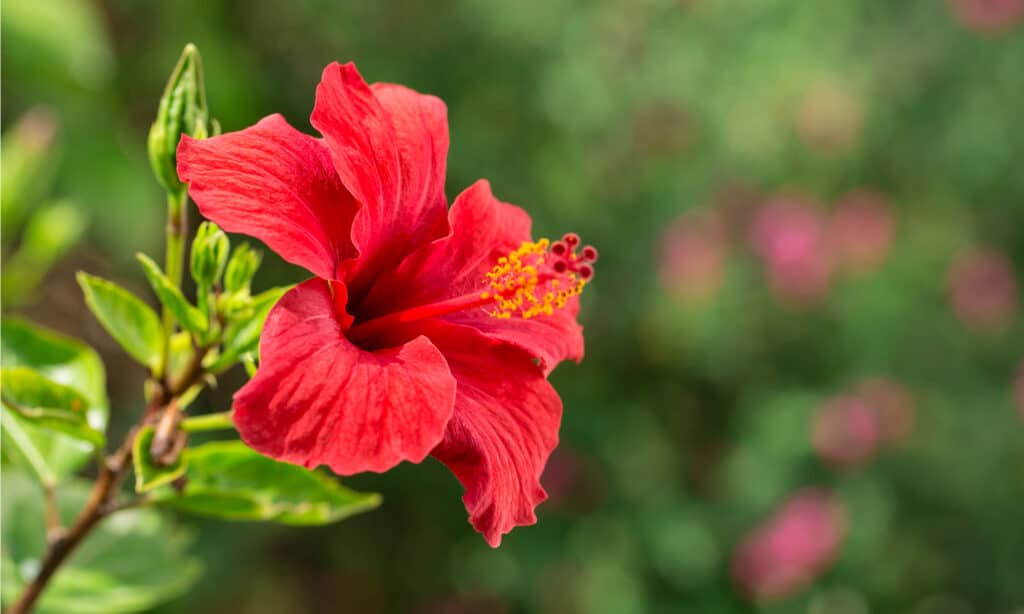
Hibiscus can be found in moist climates like marshes and swamps in eastern states and southern regions like Texas and Florida.
©APCat/Shutterstock.com
Yes, this plant is as amazing as it appears to be. Huge flowers and intriguing serrated leaves with a Cannabis appearance are distinct features of the Texas Star Hibiscus. Like the Asiatic lily, the flower has large, conspicuous blossoms that may be seen from a distance.
On stems of palmately lobed leaves with three to seven segments, the Texas Star Hibiscus bears huge, solitary, scarlet flowers that are three to four inches wide. These 10-foot-tall plants bloom with enormous white, pink, red, and fuchsia colors from July until frost. They die back into the ground in the winter, but in the spring, they quickly reappear. Hibiscus can be found in moist climates like marshes and swamps in eastern states and southern regions like Texas and Florida.
They do need warmer environments with sufficient humidity for growth. The hibiscus grows well as long as summertime temperatures don’t go above 95°F (35°C).
2. Blaze Rose

The lovely, low-maintenance Blaze Rose blossoms abundantly all summer long.
©RussieseO/Shutterstock.com
Roses come to mind first when you think of red flowers. Although you can try several rose plants to find the color you want, there’s a good possibility that the Blaze Rose will satisfy your needs. The lovely, low-maintenance Blaze Rose blossoms abundantly all summer long. This plant is perennial and drought-tolerant with few to no pest problems and many flowers that are excellent for cutting. Since the petals on the Blaze Rose are so fiery red, the name fits perfectly! Thanks to its distinctive multi-petaled blossoms that curl up and out, it never fails to astound.
3. Chianti Sunflowers

Chianti sunflowers are distinguished by their deep crimson wine-colored petals.
©Molly Shannon/Shutterstock.com
Chianti sunflowers are among the darkest varieties and are distinguished by their deep crimson wine-colored petals. Sunflowers from Chianti defy the conventional wisdom about what they look like. An intensely colored and diversified flower that starts wine red on the interior and concludes with yellow on the outer petal fringes can be found in place of the typical yellow cheer. Sunflowers are typically considered annuals, but they are worth the effort to keep.
4. Paprika Yarrow
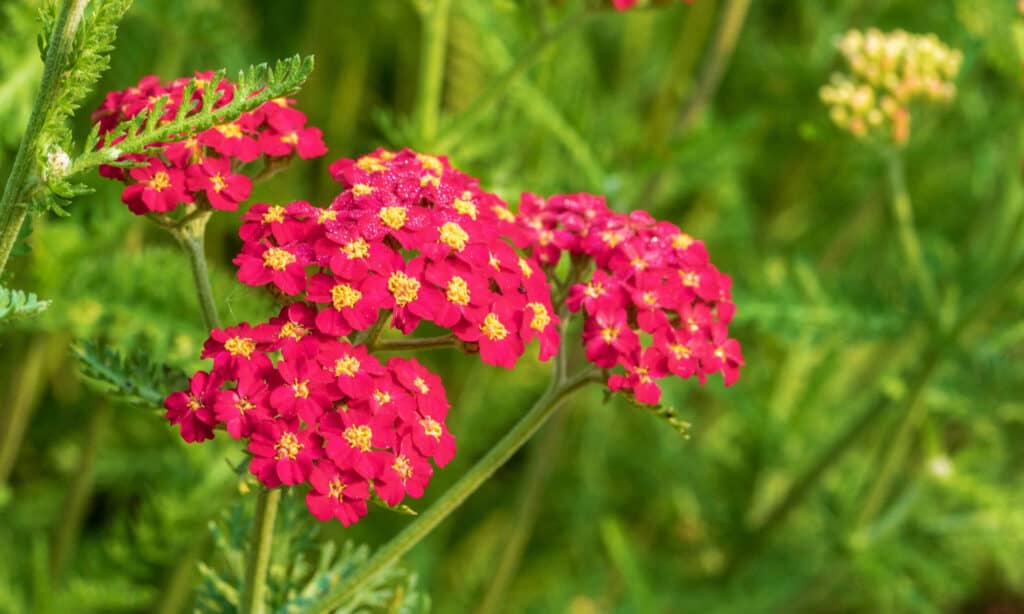
While Paprika Yarrow doesn’t require much water, it does need a lot of sunlight to grow to its full potential.
©Jennifer Yakey-Ault/Shutterstock.com
Paprika Yarrows are unusual plants with red and yellow flowers that appear to change shapes. Depending on your vantage point, the flower cluster may look like strawberries, mushrooms, or even improvised natural umbrellas. It’s understandable why they’re popular in Texas landscapes and gardens. These evergreen red flowers are extremely drought-resistant and require little to no maintenance to bloom all summer. While Paprika Yarrow doesn’t require much water, it does need a lot of sunlight to grow to its full potential.
In addition to nearly all of North America, Europe, the majority of Asia, the Indian subcontinent, and even some of Mesoamerica, it is native to Texas. Additionally, it keeps deer and rabbits away, is bee-friendly, and draws butterflies to your garden.
5. Tropical Sage
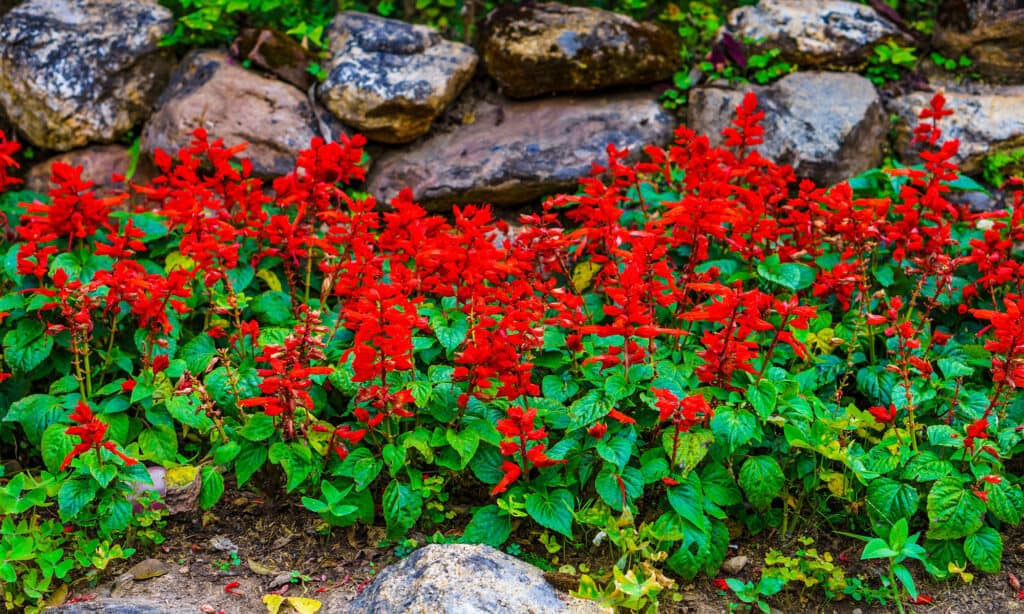
The tropical sage doesn’t require frequent watering as it only requires little upkeep.
©JoeyPhoto/Shutterstock.com
Texas sage, scarlet sage, or tropical sage, is a herbaceous perennial common in the southeast United States, Central America, the Caribbean, Mexico, and northern South America. Although the plant self-seeds and goes dormant throughout the winter before waking up in the spring, it is not an invasive species. The Texas sage’s line-shaped flowers meld flawlessly with the plant’s vibrant green leaves.
Around the world, it is grown in both private gardens and urban green spaces. The tropical sage doesn’t require frequent watering or fertilization because it requires little upkeep. To grow the tropical sage, set aside a location in your garden or yard that receives enough sunlight.
6. Asiatic Lily

The Asiatic lily follows the general rule that lilies need very little water.
©svf74/Shutterstock.com
The Asiatic lily is a must-have if you desire to have the largest red blooms in your neighborhood. Asiatic lilies produce the earliest lily bloom when planted in the landscape. Once you have a basic understanding of how to grow Asiatic lilies, caring for them is easy. The Asiatic lily follows the general rule that lilies need very little water. Start them as bulbs and place them in areas with lots of natural light to observe the emergence of the first leaves. Understanding the proper planting techniques for Asiatic lilies is the key to getting stunning, long-lasting blooms. On this valuable perennial, you’ll get colorful, abundant blooms as a reward.
7. Crepe Myrtle

Crepe myrtles can flourish in various soil types, including the alkaline, dark clay that makes up a large portion of North Texas.
©iStock.com/eddiesimages
Crepes exist in different shapes and sizes and, until recent years, were available in every hue but red. However, since the red cultivars gained popularity, they have been in high demand, and for a good reason. With its vibrant summer and fall blooms and range of sizes and colors, the crepe myrtle is a southern beauty. Due to its long blooming season, it has acquired the nickname “flowering tree of 100 days.” Crepe myrtles can flourish in various soil types, including the alkaline, dark clay that makes up a large portion of North Texas. They are resilient plants available in various colors to help you achieve the best visual result.
8. Home Run Rose

Home Run rose can withstand drought.
©ArliftAtoz2205/Shutterstock.com
The red Home Run rose has continuous blooms and top-notch resistance to powdery mildew and black spot. Tom Carruth, whose name is connected to numerous AARS (All-American Rose Selection) Award-winning roses, is the guy behind the breeding of the lovely brilliant red-blooming rosebush known as “Home Run.” The foliage is densely colored dark green and naturally rounded, and it can withstand high and low temperatures and doesn’t need deadheading. The fact that these flowers are maintenance-free, disease-free, and bloom as open red roses from spring to fall makes them even better. They can also withstand drought and are evergreen.
9. Bat Face Cuphea
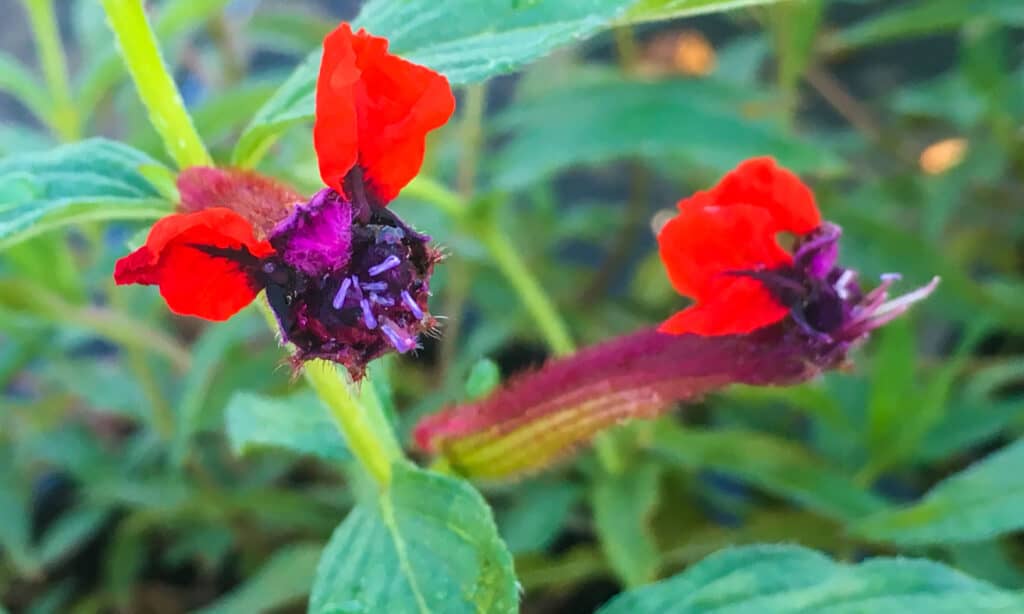
Endemic to Mexico, bat-faced cupheas do well in full sun sunlight and moderate shade.
©Matt Howard/Shutterstock.com
Bat-faced cuphea or red cuphea of the loosestrife family is endemic to Mexico. Rounder, red and purple flowers of the bat-faced or “bat face” cuphea resemble small bat faces. They do well in full sun and moderate shade, with very little additional irrigation. They’ll bloom continuously from late spring/early summer until the first frost. Cuphea will remain evergreen during milder winters, but it may be deciduous in colder years. After the final frost date, just prune back dead growth to promote new growth. If the temperature drops into the 20s, it would be wise to preserve the bat-faced cuphea because it is a little more sensitive to the cold.
10. Red Prince Weigela

Although weigela is adaptable and can grow in both full sun and partial shade, planting your shrub in full sun will result in better blooms.
©krolya25/Shutterstock.com
The multi-stemmed, tall, dense, and deciduous shrub known as “Red Prince” can reach heights and widths of up to 9 feet. This is a great option for a hedge or border because of its compact form, lush foliage, and blossoms. The optimal time to prune and shape a plant is after it has finished flowering. These flowers retain their vivid red color from late spring to early summer. Occasionally, the plant will rebloom in late summer or early fall with fewer flowers.
Although weigela is adaptable and can grow in both full sun and partial shade, planting your shrub in full sun will result in better blooms. The full-sun rule has two exceptions. First, a little afternoon shade helps to safeguard the plant in the hottest parts of the nation. Second, cultivars with variegated leaves tend to burn in the hottest climates if exposed to full sun.
11. Indian paintbrush

Indian paintbrush blooms can be eaten.
©iStock.com/leekris
A genus of roughly 200 species of annual and perennial herbaceous plants endemic to the western Americas, northern Asia, and one variety as far west as northwest Russia, known as Indian paintbrush or prairie-fire, is an early spring flower that blooms all around the state. The bracts’ colorful tips give the appearance that they have been painted. Numerous species come in various hues, including red, cream, yellow, orange, and rarely purple. Indian paintbrush blooms can be eaten, and certain Native American cultures used them as a seasoning with other fresh greens.
12. Drummond phlox
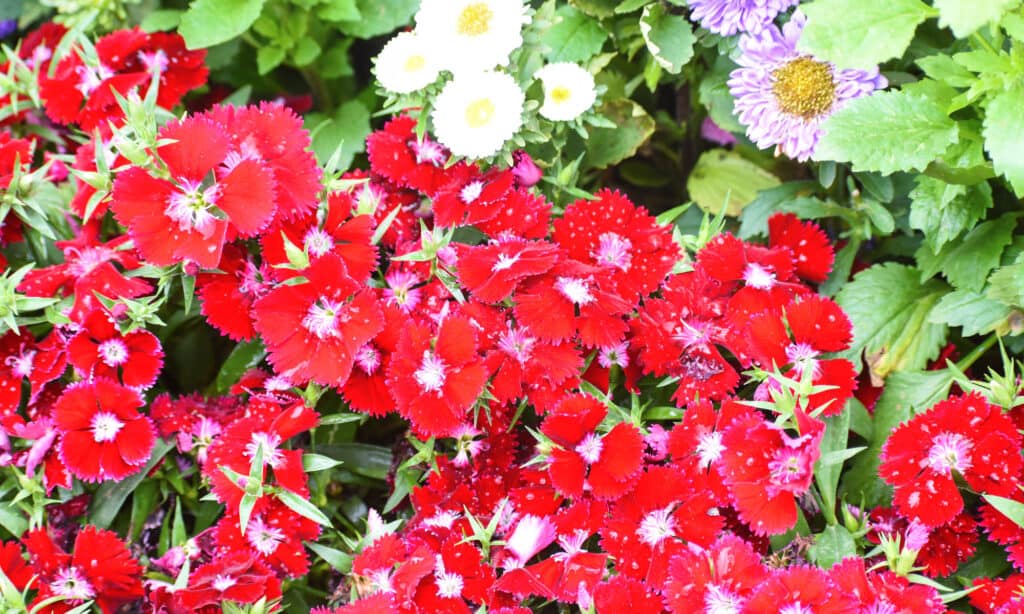
Phlox drummondii is named after Scottish botanist Thomas Drummond.
©ELAMARAN ELAA PHOTOGRAPHY/Shutterstock.com
A blooming plant belonging to the genus Phlox and family Polemoniaceae is called Phlox drummondii. It is widely dispersed in the southeast of the United States, particularly along public highways, and is a native of Texas. In South Central Texas, this flower blooms in the early spring and is usually found in stunning heaps of color among sandy post-oak forests and along the roadside. Phlox drummondii is named after Scottish botanist Thomas Drummond, who collected samples of it and numerous other plants during his 1833–1835 journey to Texas and returned them to Britain. The petals of the single or double flowers are flat, star-shaped, and mildly fragrant.
Up Next:
17 Gorgeous Flowering Trees in Texas
Vines in Texas: Vines Found Across the Lonestar State
Tulips in Texas: Types and When they Bloom
The photo featured at the top of this post is © JoeyPhoto/Shutterstock.com
Sources
- HighlandLakes.com, Available here: https://www.101highlandlakes.com/news/hill-country-wildflower-identification-guide
- Texas Highways, Available here: https://texashighways.com/wildflowers/wildflowers-of-texas/
- GFLOUTDOORS, Available here: https://www.gfloutdoors.com/red-flowers-in-texas-7-stunning-plants-to-add-to-your-yard/
Thank you for reading! Have some feedback for us? Contact the AZ Animals editorial team.







